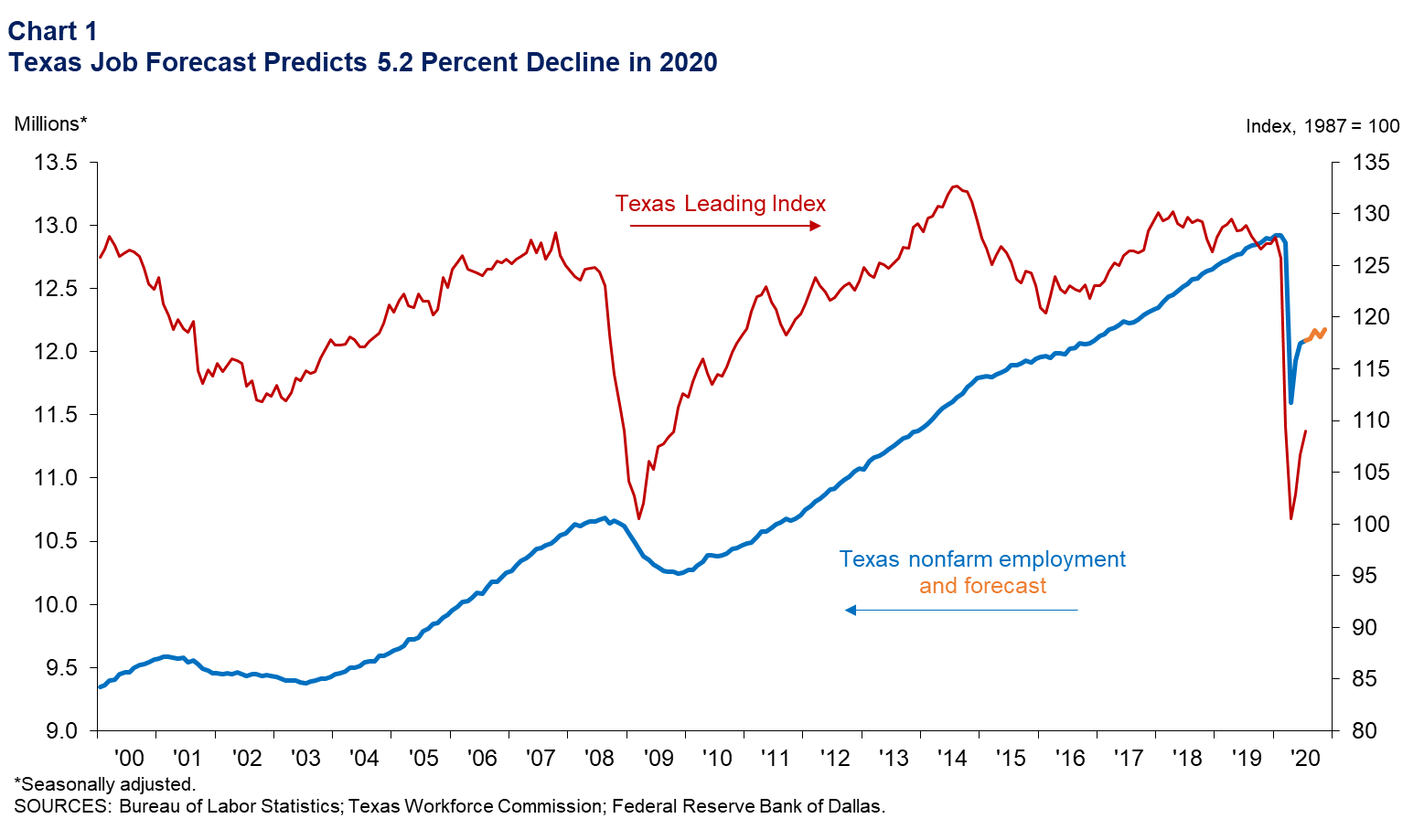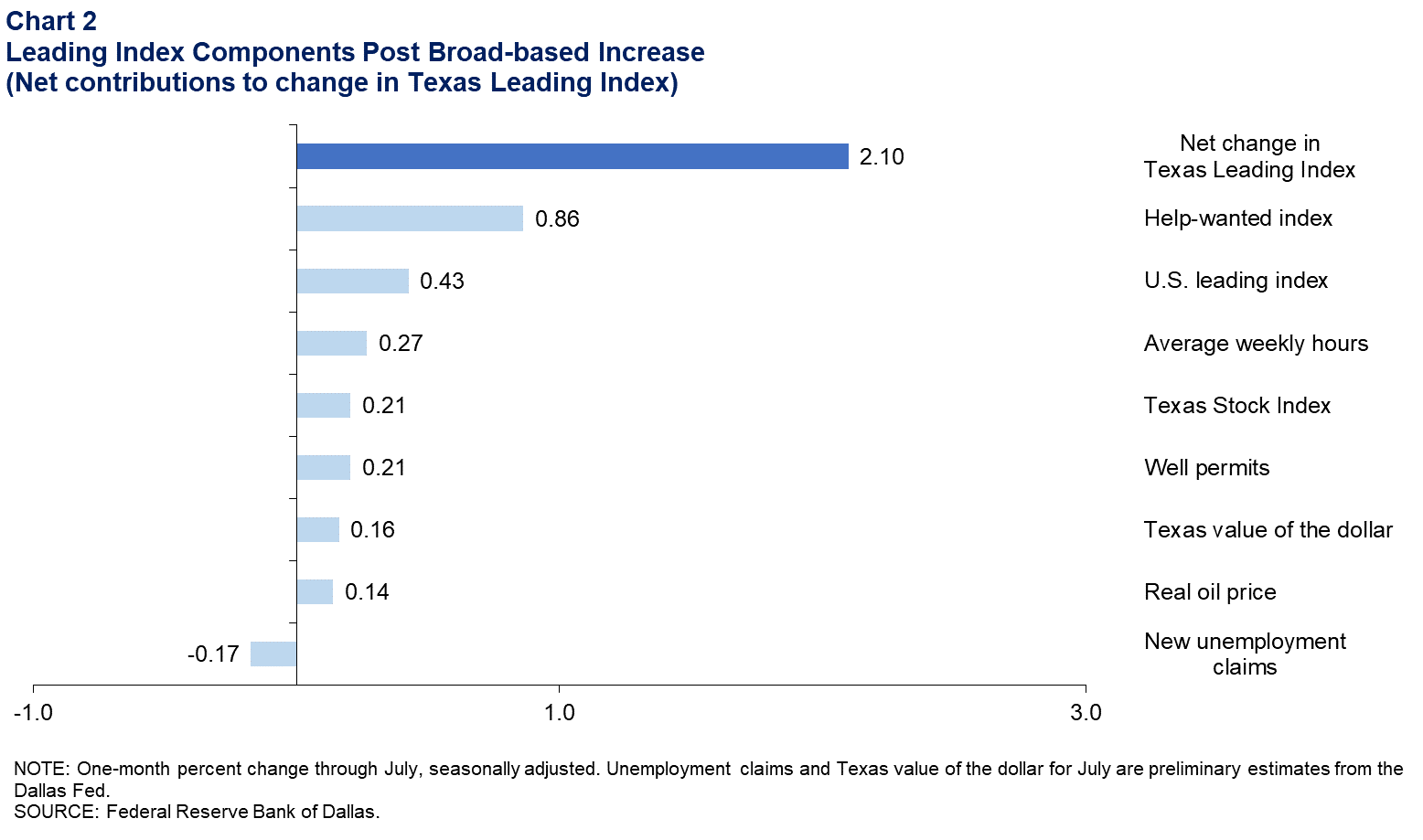Texas Employment Forecast

August 21, 2020
Texas job growth fell to 2.5 percent in July after increasing a revised 14.7 percent in June. Private sector jobs fell 1.1 percent. Employment is down 10.4 percent since December 2019. The Texas Leading Index increased for the third consecutive month in July after sharp declines in March and April.
Using a top-down model based on national forecasts, COVID-19 infection rates and oil futures prices, we estimate that Texas jobs will continue to recover in the second half of the year but not enough to fully offset the losses in March and April. The Texas Employment Forecast projects jobs will decline 5.2 percent this year (December/December). Based on the forecast, 672,000 jobs will be lost in the state this year, and employment in December 2020 will be 12.2 million (Chart 1). Forecast uncertainty remains elevated as daily new COVID-19 infections in Texas peaked in mid-July but have declined at only a gradual pace.
“After a strong bounce back in May and slower but still strong growth in June, job growth slowed sharply in July after a resurgence of new COVID-19 cases began in mid-June. High-frequency data had suggested a sharp slowing in July, and while this same data suggest some improvement in early August, further declines in COVID-19 cases will likely be necessary for a significant acceleration of jobs,” said Keith R. Phillips, Dallas Fed assistant vice president and senior economist. “Currently, we expect job growth to be about 2.1 percent in the last five months of the year. If the virus stalls out and fails to decline, job growth may be weaker, but if new cases drop sharply, job growth would likely be stronger.”
Government jobs surged in July due to a large increase in public school employment. Private industry jobs declined, led by losses in leisure and hospitality, trade, construction and manufacturing. Job growth was positive but significantly weaker across all of the large metro areas in the state with the exception of Houston and San Antonio where jobs declined.
The Texas unemployment rate decreased from a revised 8.4 percent in June to 8.0 in July. After growing at a strong pace of 2.2 percent (non-annualized) in June, labor force growth slowed to 0.2 percent in July.
The Texas Leading Index increased for the third consecutive month in July (Chart 1). Seven of the eight indicators gave positive contributions to the leading index (Chart 2). A sharp increase in help-wanted advertising provided the strongest positive signal, followed by a gain in the U.S. leading index. Moderately positive contributions also came from gains in average weekly hours worked in manufacturing, the stock prices of Texas-based companies, permits to drill oil and gas wells, and the price of oil, along with a decline in the Texas trade-weighted value of the dollar. A rise in initial claims for unemployment insurance gave a slightly negative contribution.


Next release: September 18, 2020
Methodology
The Dallas Fed Texas Employment Forecast projects job growth for the calendar year and is estimated as the 12-month change in payroll employment from December to December.
Due to the rapid onset of the COVID-19 pandemic, the forecasting model used in this release of the Dallas Fed Texas Employment Forecast differs from the model used historically. In this case, payroll employment for June to December, is estimated based on expectations for U.S. GDP growth for the remainder of 2020, an estimate of direct COVID-19 impacts in March, April, and July, and expected prices of West Texas Intermediate crude oil based on the futures curve.
For additional details see http://dallasfed.org/research/forecast/
Contact Information
For more information about the Texas Employment Forecast, contact Keith Phillips at keith.r.phillips@dal.frb.org or Christopher Slijk at christopher.slijk@dal.frb.org.